Recently at the Brookings Center for Universal Education (CUE), we were joined by colleagues from around the world in a two-day conference to discuss the status of global education and strategies for future action. Activities during the two-day conference included: a public event with United Nations Special Envoy for Global Education Gordon Brown and Director of the White House National Economic Council Gene Sperling; a private meeting with a delegation from the Democratic Republic of the Congo; a meeting convened by Women Thrive Worldwide; a private all-day research symposium on ‘Learning in the Developing World’; and presentations by CUE’s Global Guest scholars.
The central theme of the events was to understand the new opportunities that Education First, the U.N. secretary-general’s new five-year global education initiative, affords our community. There was broad agreement that this new initiative has the potential to be a game-changer in global education if it succeeds in its mission to, in the words of Carol Bellamy, get existing and new actors alike to “do more and do better.” Not only does Education First inject much needed leadership and energy into global education advocacy and provide a bold vision for the future, but it also puts forward a set of concrete steps for actors to take if they want to lend their hands to the effort.
Education First aims to put children in school, ensure quality learning, and foster global citizenship and outlines 10 key actions to make these goals happen. In our discussions there was considerable interest in the specific targets set forth in the initiative and agreement that if Education First is to be successful, actors should focus on tackling different priorities in-line with their scope of work. In addition to governments, multilateral agencies and civil society organizations, participants expressed interest in ensuring business and private philanthropists align their efforts with the Education First agenda. The 10 key actions and the specific targets within them are collectively quite an ambitious and broad agenda. They include:
- Enroll all children in school. This goal provides an extra push to meet the education Millennium Development Goals (MDGs) and includes an important focus on gender, while also removing cost barriers and access inequities at both the primary and secondary level. In his speech, Gordon Brown spoke about his plan to work closely over the next several months with World Bank President Jim Kim and several heads of state, including, India, Pakistan, Nigeria and the Democratic Republic of the Congo, to accelerate progress toward these goals. He plans to hold an education summit with ministers of finance and education from these countries and others during the World Bank’s annual spring meetings to pressure governments and donors alike to ramp up action.
- Sustain education in humanitarian crises, especially conflict. This goal shines a much needed spotlight on the plight of children affected by emergencies – which comprise a large percentage of those who miss out on quality learning opportunities. It calls for education to be protected during conflict and for development specialists to make sure national education plans have strategies for continuing learning if disaster should hit. But perhaps my favorite target is the call to “make education a central pillar of every humanitarian response – ensuring education is at least 4 percent (up from 2 percent) of the overall humanitarian budget.” Lori Heninger, the director of the Inter-Agency Network of Education in Emergencies, representing some 8,000 members around the globe, announced that they would be bringing their substantial weight to bear on this goal through a new advocacy initiative.
- Ensure all children are literate and numerate. As Gene Sperling stated in the discussion, there are some times when you have to “walk and chew gum at the same time” and putting all children in school and ensuring they learn well while there is one of them. In this key action, the Education First initiative moves beyond the MDG mandate to focus on education quality by calling for all children to be fully literate and numerate after four years in school. This global learning target is being discussed in relation to the post-2015 development agenda. There is a need to work with ministries of education to make sure learning resonates at the country level. However it is also necessary to align targets within international donor agencies as different organizations currently have different goals: USAID identifies literacy at grade 2, the Global Partnership for Education at grade 3, and now Education First at grade 4. The role of the Learning Metrics Task Force, which is jointly convened by the UNESCO Institute of Statistics and the Center for Universal Education at Brookings, is helping to sort through some of these issues. The task force facilitates a process to begin a global dialogue between countries and actors on these learning issues. The focus of the task force is to find ways to measure a broad range of important metrics to ultimately help improve students’ learning achievement. Helping to identify a small number of those metrics that could go into the next global development agenda is one part of, but not the sum total, of the effort. Indeed the task force’s work is very closely linked with one of the Education First strategies, which is to “track every student’s learning outcomes, and use the information to help improve their achievement.” Interestingly the task force’s purpose parallels comments made by Homi Kharas, in showing an openness to identifying education and learning targets in the next global development agenda for which we do not currently have good measures.
- Train more teachers. There is a major shortage of teachers, especially those working in low-income countries. During our conference, questions around how to best retain and support teachers were discussed, especially in light of Education First’s targets to hire 2 million more teachers, and ensure all teachers are well-trained and have improved conditions of service. Ensuring teachers who have left the profession are brought back was mentioned as an important strategy for addressing these issues. Education International and the Global Campaign for Education shared a new initiative they have launched, titled Every Child Needs a Teacher, to advocate that every child has a trained teacher.
- Equip classrooms with books and learning materials. Education First calls for 4 million more classrooms to be built in marginalized communities, and for teaching and learning materials to be readily available. Also important for thinking about ways to go to scale, technology needs to be harnessed to both expand the reach of teaching and learning materials as well as improve their quality. How to leverage things such as e-readers with solar power, or mobile phones to help with this issue remains one of the key questions needing further research.
- Prepare students for livelihoods. This key action seriously considers the secondary education needs by calling for the global community to halve the number of adolescents out of lower secondary school, ensure that education is relevant for local economies and livelihoods, and prepare young people with critical thinking and 21st century skills. It is also a call to provide alternative learning opportunities for those youth who have missed out of formal schooling. Achieving this was discussed in depth both in reviewing this year’s Education for All Global Monitoring Report recommendations and in debating the issues with academics in our research symposium. The role of non-cognitive attributes – such as communication, collaboration, empathy and determination – was hotly debated in the research symposium. During the research symposium, James Heckman of the University of Chicago and Larry Aber of New York University argued for a much more robust policy orientation around the cultivation of non-cognitive attributes in education systems. Building the foundation for these skills during early childhood and cultivating them through primary and especially during post-primary education is a missing link to improving life outcomes as well as learning outcomes.
- Improve child nutrition. Ensuring young children get a successful start on life through proper nutrition is just as important for educational outcomes as is the range of education system inputs typically focused on. Education First calls for the number of children under age 5 who suffer from stunted growth be cut in half, as well as to improve social supports that deliver nutrition to those in need – either through schools or communities. Forging bridges between sectors is something that the MDGs have not been very successful in doing given their sectoral, and hence siloed, nature. However, cross-sectoral collaboration is essential for human development, as discussed during the Women Thrive Worldwide side meeting. Many of the presenters at our event discussed the common ground between health and education, agriculture and education, and women’s empowerment and clean water in particular as they relate to forging a common cause for the next post-2015 development agenda.
- Instill life-long learning. Coupled with the target of reducing child stunting, these specific calls for action make a powerful case for how to move forward early childhood development, even if not labeled as such. This includes increasing the participation in quality early childhood development programs for marginalized children in low-income countries from 15 to 45 percent, as well as halving the number of illiterate women and men by 2015. As is too often the case, the question of adult education received very little airtime in these discussions, although early childhood development was fulsomely debated in the research symposium.
- Foster global citizenship. What global citizenship means, why it is important, and how to measure it was discussed heavily during the proceedings. Particularly insightful were comments from Patrick Awuah, founder of Asheshi University in Ghana, which uses a purposeful global citizenship model of education. The benefits are not only in the ethical development of students, as Patrick is quick to point out, but also in their employability. His university transitions students to employment at higher rates than any other institution in Ghana. The focus within Education First is to develop the values, knowledge and skills necessary for peace, tolerance and respect for diversity, cultivate a sense of community and giving back to society, and ensure schools are safe and free of any form of violence or harassment.
- Close the financing gap. Those who have critiqued the secretary-general’s initiative as not having clear financing targets, should think again. The call is for at least 5 to 6 percent of national GDP to be invested in education, and for the global community to support low-income countries with an additional $24 billion per year to fill the financing gap for primary and lower secondary education, and to ensure effective and accountable use of resources aligned with national education plans.
Clearly there is a wide range of important topics for all actors concerned with education to contribute to a part of this broad agenda. Indeed, combining all our efforts–from developing country actors to multi-lateral institutions, civil society, business, media and philanthropy—is the only way this vision will move from a potential game-changer to an actual force for change.
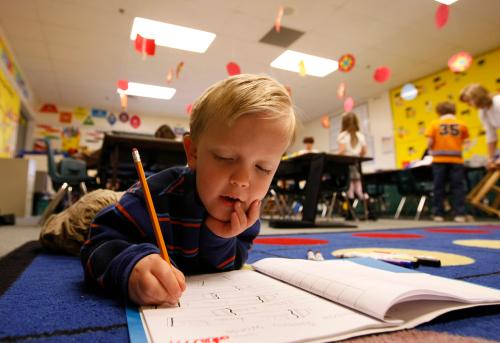
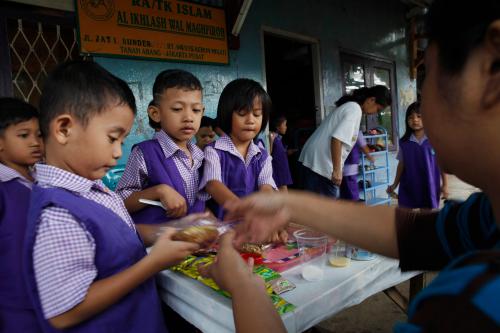
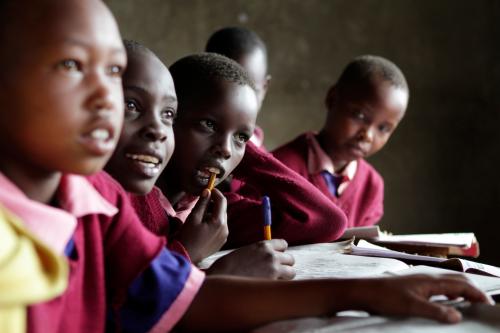

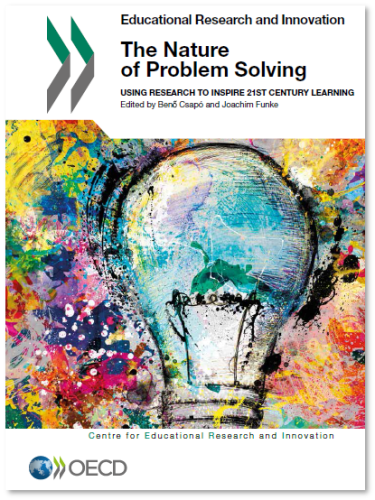
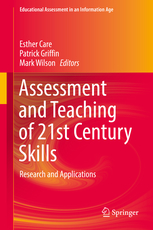
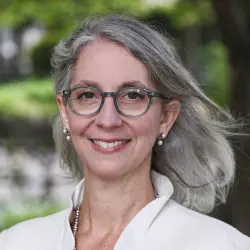



Commentary
A Game-Changer for Global Education
December 19, 2012